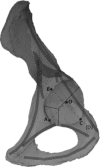Study of the three-dimensional orientation of the labrum: its relations with the osseous acetabular rim
- PMID: 22360458
- PMCID: PMC3403280
- DOI: 10.1111/j.1469-7580.2012.01486.x
Study of the three-dimensional orientation of the labrum: its relations with the osseous acetabular rim
Abstract
Understanding the three-dimensional orientation of the coxo-femoral joint remains a challenge as an accurate three-dimensional orientation ensure an efficient bipedal gait and posture. The quantification of the orientation of the acetabulum can be performed using the three-dimensional axis perpendicular to the plane that passes along the edge of the acetabular rim. However, the acetabular rim is not regular as an important indentation in the anterior rim was observed. An innovative cadaver study of the labrum was developed to shed light on the proper quantification of the three-dimensional orientation of the acetabulum. Dissections on 17 non-embalmed corpses were performed. Our results suggest that the acetabular rim is better represented by an anterior plane and a posterior plane rather than a single plane along the entire rim as it is currently assumed. The development of the socket from the Y-shaped cartilage was suggested to explain the different orientations in these anterior and posterior planes. The labrum forms a plane that takes an orientation in between the anterior and posterior parts of the acetabular rim, filling up inequalities of the bony rim. The vectors V(L) , V(A2) and V(P) , representing the three-dimensional orientation of the labrum, the anterior rim and the posterior rim, are situated in a unique plane that appears biomechanically dependent. The three-dimensional orientation of the acetabulum is a fundamental parameter to understand the hip joint mechanism. Important applications for hip surgery and rehabilitation, as well as for physical anthropology, were discussed.
© 2012 The Authors. Journal of Anatomy © 2012 Anatomical Society.
Figures





References
-
- Baylac M. Rmorph a morphometric library for R. 2010. Available from the author: baylac(at)mnhn.fr.
-
- Bullough P, Goodfellow J, Greenwald AS, et al. Incongruent surfaces in the human hip joint. Nature. 1968;217:1290. - PubMed
-
- Bullough P, Goodfellow J, O’Connor JJ. The relationship between degenerative changes and load-bearing in the human hip. J Bone Joint Surg Br. 1973;55:746–758. - PubMed
-
- Calandruccio RA. Arthroplasty of the hip. In: Crenshaw AH, editor. Campell’s Operative Orthopaedics. Vol. 2. St Louis: CV Mosby; 1987. pp. 1213–1501.
Publication types
MeSH terms
LinkOut - more resources
Full Text Sources

